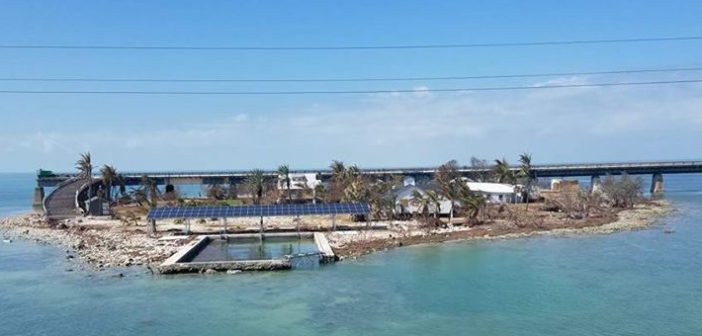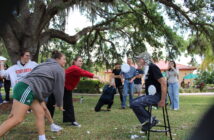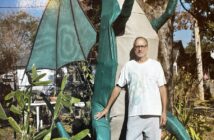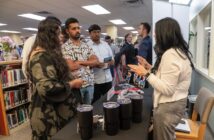[tribulant_slideshow gallery_id="145"] |
In a matter of weeks, both Hurricane Harvey and Hurricane Irma has caused major damage in the United States, affecting Texas, Florida, Georgia, Alabama, and North Carolina. These hurricanes caused significant damages to properties and even resulted in numerous deaths. The storms also affected the Saint Leo main Campus and Centers. About 8,000 students were impacted by Hurricane Irma and Hurricane Harvey, according to University Communications.
Following Corpus Christi being impacted by Hurricane Harvey in early Sept, there were numerous initiatives on the University Campus helping out those affected. In fact, in a message to students, President Dr. William J. Lennox Jr. suggested ways to assist the situation, such as helping students who may call or email for help, keeping victims in one’s prayers, and donating to an organization that are on the ground giving aid. There were also efforts from individual organizations on campus, including the TKE fraternity, who held a pie-throwing fundraiser to raise money for Red Cross to help the victims of Hurricane Harvey.
Only days after Hurricane Harvey wreaked havoc in Houston and other parts of Texas did Hurricane Irma follow suit, bringing chaos to the Caribbean and multiple southeastern states. In spite of the storm, there were many initiatives from the Saint Leo community banding together before, during, and after the storm. In fact, Lennox commented on this in another message to the student body.
“The devastation hit us first in the west as Hurricane Harvey landed in Texas, including Corpus Christi. Then Irma’s impact began this past Sunday at our southernmost location in Key West and continued north through Florida, Georgia, and South Carolina with 27 of our locations impacted,” said Lennox “It is at moments like these that the vast reach of our university becomes very clear. In addition to our outreach to faculty, staff, and students at these locations, the huge network of our online students and adjunct faculty was a concern. And finally, our thoughts also turned to the tens of thousands of alumni in the paths of these two storms.”
As Lennox mentioned, Hurricane Irma caused damage in the states of Florida, Georgia, and North Carolina, affecting numerous centers. The first Center impacted by this storm was the Key West Center. Hurricane Irma was a Category 4 storm when it made landfall in the Florida Keys, according to ABC News. The Keys took a brutal hit from the Hurricane; according to CBS News, FEMA estimated that 25 percent of homes were destroyed due to the strong forces of the hurricane; however, not all buildings took a major hit, including The Key West Center. According to the Key West Center director, Alaina Plowdrey, there was only minimal damage suffered by the hurricane; the damages include a soaked rug and an office tile leaking minimally. However, some students and faculty’s property did not fare so well.
“For the most part, they are doing well, respectively. Some faculty members have lost large portions of their homes, vehicles, and boats. I am currently calling all students I haven’t spoken to already this week to assess their conditions post-Irma and abilities to continue on in their courses. Many of the faculty, students and staff are still away,” said Plowdrey.
Reentry to Florida Keys began Sept. 17; however, there is limited resources, such as clean water, electricity, and food, according to Plowdrey.
Before, after, and during hurricane Irma, the Center was able to stay in touch with the students, faculty and staff for the hurricane, with 90 percent of the student population evacuating the area.
“The faculty members in Key West have been amazing in making sure their students are doing well, keeping them informed and granting them enough time to finish assignments while we wait to return. Online faculty has also been extremely helpful in granting extensions,” said Plowdrey. “We still have students without internet and most of our faculty, staff and student body just regained phone service a few days ago. Consistency in outreach, emails and phone calls, has been applied in this situation to ensure safety and contact for all.”
Following the storm, the priorities are to ensure the safety of the people at the Center and to ensure students continue with schooling.
“First and foremost to know my students, faculty and staff are safe, second to begin an estimated plan of re-opening and make sure students that want to continue their courses for FA1 have adequate extensions, support and resources and those who want to drop due to their homes being damaged or the demands of work are able to and have a successful plan for the next term,” said Plowdrey.
Other than the Florida Keys, Hurricane Irma struck numerous places in South Florida, such as Miami and Naples. Central Florida was anticipating the storm to cause destruction as well. In fact, according to WFLA, to prepare for the storm, about 28,000 people were in shelters in the Hillsborough County, which is the county that Tampa Bay and St. Petersburg is in. When the hurricane arrived in the Tampa Bay and St. Petersburg area, according to The Washington Post, the storm was merely a Category 1 storm, and didn’t cause any significant damage. Nevertheless, during and after the storm, many people in the area lost power. This was a part of the 6.5 million Florida residents without electricity on Monday, Sept. 11, which was around the time the storm was leaving Florida, as reported by NBC News.
Other than University Campus, the Hurricane Irma also past Centers, such as Tampa Center and the Ocala Center, which all were closed due to the storm.
Then, Hurricane Irma moved more up north to affect the Lake City Center, which is located in North Florida. The center has a total of 132 students and one full-time faculty member. This Center has not sustained damages to the office, but host college sustained some damages.
Like many of the centers that prepared for the storm, the Lake City Center closed the Center days before the hurricane arrived to ensure that students and faculty to prepare for the storm.
“We closed the center at noon on Thursday 09/07 to allow time for our students, staff, and faculty to be able to get their homes prepared, buy non-perishables, water, and fill their gas tanks since, at that point in time, those things were already running low in Lake City. The extra time allotted allowed us time to get the things we all needed to make sure we were fully prepared to be without power for a few days,” said Jessica Markham, the director of the Lake City Center.
And to keep in touch with students, the Center posted on the Facebook page, and Markham was able to personally call the staff members to keep them updated as well; however, she faced some difficulty due to power and internet being lost. Nevertheless, after the hurricane passed, the main priority for the center, according to Markham is to “get back to normal as quickly as possible and make sure students feel comfortable about catching up on their coursework.”
“The students are my main concern, and I want to make sure they are aware that we are communicating with faculty and making sure they understand the hardship our students are facing since many are still without power/internet, and this will definitely impact their ability to get assignments caught up and completed on time,” added Markham.
Lake City Center, which is located near the Florida-Georgia Border, was the last Center in Florida to get hit by the storm before the storm left Florida on its way to Georgia.
By the time Hurricane Irma reached to Georgia, the storm still was able to cause damage. About 450,000 people had to evacuate from Savannah and the from the coast, according to ABC News. Also, the storm surge and rains resulted in property damage and even flooding to the coastal areas. The winds also resulted in trees being ripped from the ground and hurling toward many homes, causing property damages and even resulting in at least three deaths, according ABC News.
Hurricane Irma caused further damage in Georgia, with reports that 1.5 million customers of Georgia Power and EMC being without power. Following the storm, the Georgia Power Company tweeted it is working to repair the damaged power lines and poles to help residents restore power and, according to Fox News, with the help of Army National Guard, local police had plans in progress to remove trees and downed power lines from the area to clear roadways.
The Saint Leo Savannah Center, which has 700 active students and 50 instructors, did not sustain major damages, according to Stephanie Stinski, the director of the Savanah Center. However, some of the students and faculty has faced damages: some without power and some with tree or flood damage. The powers are trying to be restored and the damages from flooding and trees are being assesses.
To prepare for the storm, like many Centers, the Savanah Center was able to close the Center early to ensure that students and faculty were able to prepare adequately for the storm.
“We closed the center starting on Friday, to give our students, faculty and staff time to make a plan that was best for their family; to either evacuate or make the decision to shelter in place during the storm,” said Stinski. “The majority of the city evacuated, which meant that our students, faculty and staff would need time to find shelter and to get to their destination (through hours of traffic) before the storm approached our area.”
The Center was able to keep in touch with faculty members and students through emails and Regroup phone messaging to ensure the safety of the people from the center.
“We were able to keep in contact daily with our students, faculty, and staff to relay information regarding the closure of the center, during the storm, assessing damage after the storm, and the reopening of the center. Many of our students and faculty lost power, so we wanted to be sure to reopen the center as soon as conditions were safe and the building was safe so that students could come into utilize our air conditioning, computer lab/internet, and student lounge area,” said Stinksi.
Also, the Center’s main priority is to ensure the safety of the faculty and students and help students to be successful in their classes, which may include allowing students who aren’t in the local area or has sustained damages, to have additional time to submit their work or have excused absences.
“We have some students and faculty that have not made it back to the local area, so we are contacting the students in classes that will not meet due to the storm and relaying information to both students and faculty on the availability of classrooms to make up missed class sessions, or to be utilized for study groups to prepare to return to class,” said Stinski. “We want to support our students and faculty in any way that we can, which may result in delayed class meetings. We are staying in contact with our students and faculty to ensure their safety and assisting them in getting back to the local area and getting settled back in.”
Hurricane Irma caused damage to South Carolina as well, with the city of Charleston getting 4 feet of water as the eye of the storm was 250 miles ways. The North Charleston Center was closed for a bit as a result of the storm.
The Center Directors of the center affected were able to prepare the center’s students and faculty and remain in touch to ensure the safety of it students. In fact, Lennox attributed not only the staff on campus for their tireless work but also the WorldWide staff as well, including the center directors.
“While no one was looking, our center directors managed through each circumstance with grace as they balanced the need to provide services with the concern for their staffs’ and students’ personal safety and well-being,” said Lennox. “Our WorldWide staff worked to keep students informed and did their best to keep classes going throughout both events.”
Also, the University had many initiatives to ensure that the students who remained on campus as well. In fact, there were many faculty members and staff from multiple departments staying on campus to assist students, who stayed on campus. Also, there were volunteers from people outside campus assisting with the dining hall to provide food as well. Following the storm, there were volunteer opportunities for students as well; for example, some students helped Frogmore Farms to replant blueberry trees on Saturday Sept. 16.
Along with showing his appreciation, Lennox, in his message to the students, also gave advice on how people, who want to help, can help as well.
“Many of you have reached out offering to help in any way possible. Not unusual for the Saint Leo community! We expect there may be students and their families with additional financial burdens, so I have asked the staff to generate a separate appeal for those who may wish to donate to a scholarship fund to allow affected students across the university to remain in school,” said Lennox.
Lennox expressed his gratitude for the community for banning together to offer help. With the support, some Centers that were affected, like Gwinnett Center and North Charleston Center, were able to open on Wednesday, Sept. 13 but all Centers were able to reopen by Monday, Sept. 18, with the exception of the Key West Center.





